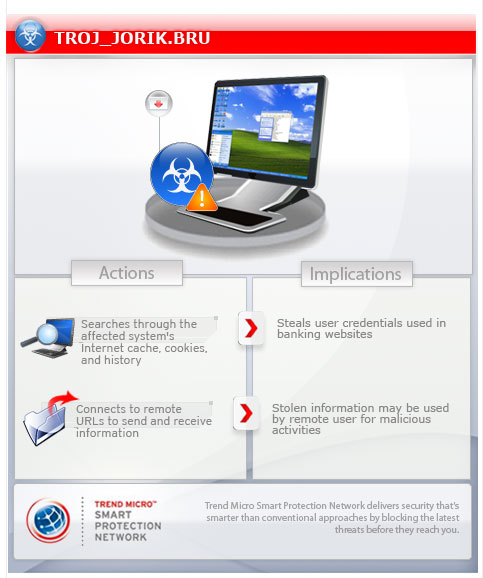TROJ_JORIK.BRU
Windows 2000, Windows XP, Windows Server 2003


Threat Type: Spyware
Destructiveness: No
Encrypted: Yes
In the wild: Yes
OVERVIEW
This spyware is the final payload of a massive Web page injection targeting osCommerce sites. It attempts to steal credit card information from the sites' potential customers.
To get a one-glance comprehensive view of the behavior of this Spyware, refer to the Threat Diagram shown below.

This spyware checks for certain information to test if it is running in a virtual machine and sandbox. It terminates and deletes itself if any of the conditions are met.
It searches through the affected system's Internet cache, cookies, and history to steal user credentials used in websites with the certain strings. It connects to certain URLs to send and receive information. It may also download additional files from these remote sites.
This spyware deletes itself after execution.
TECHNICAL DETAILS
Installation
This spyware adds the following mutexes to ensure that only one of its copies runs at any one time:
- bogestvennoe_providenie
Other System Modifications
This spyware creates the following registry entry(ies) to bypass Windows Firewall:
HKEY_LOCAL_MACHINE\SYSTEM\CurrentControlSet\
Services\SharedAccess\Parameters\
FirewallPolicy\StandardProfile\AuthorizedApplications\
List
{malware path and file name} = "{malware path and file name}:*:Enabled:ldrsoft"
NOTES:
Other Details
This spyware deletes itself after execution.
It may be downloaded unknowingly when visiting infected Web pages. An iframe inserted in the page will execute a remote script that connects to the following URL where this malware is downloaded:- http://{BLOCKED}6.{BLOCKED}6.240.18/9VBMa76FFnB4VAYu0X5j755pMiSyVrcV?s=mdacot
It checks for the following to test if it is running in a virtual machine and sandbox:
- Presence of the following files:
- %System%\drivers\prleth.sys
- %System%\drivers\hgfs.sys
- %System%\drivers\vmhgfs.sys
- dbghelp.dll
- sbiedll.dll
- Product ID is any of the following:
- 55274-640-2673064-23950
- 76487-644-3177037-23510
- 76487-337-8429955-22614
- User name is CurrentUser
- Computer name is SANDBOX
- BIOS version contains the string VBOX
It terminates and deletes itself if any of the conditions are met.
Information Theft
It searches through the affected system's Internet cache, cookies, and history to steal user credentials used in websites with the following strings:
- fiducia.de
- norisbank.de
- postbank.de
- deutsche-bank.de
- schwab.com
- saab.com
- samba.com
- abbeyinternational.com
- almubasher.com.sa
- alahliecorp.com
- alahlionline.com
- bankalbilad.com
- alinmaonline.com
- anb.com.sa
- anzdirect.co.nz
- associatedbank.com
- boveda.banamex.com.mx
- bmoharrisprivatebankingonline.com
- bnycash.bankofny.com
- ifxmanager.bnymellon.com
- businessmanager.com
- banking.calbanktrust.com
- /cmserver/
- ibanking-services.com
- /cashplus/
- businessbanking.cibc.com
- cibconline.cibc.com
- citigroup.com
- commbiz.commbank.com.au
- compassbank.com
- cashanalyzer.com
- ebanking-services.com
- ebc_ebc1961
- fransiplus.com
- /cashman/
- .efirstbank.com
- treas-mgt.frostbank.com
- business.hsbc.co.uk
- businessonline.huntington.com
- online-business.lloydstsb.co.uk
- businessportal.mibank.com
- webbankingforbusiness.mandtbank.com
- banking.mashreqbank.com
- premierview.membersunited.org
- cashmanager.mizuhoe-treasurer.com
- .nabconnect.nab.com.au
- .enternetbank.com
- northerntrust.com
- /Common/SignOn
- /CLKCCM/
- /onlineserv/CM/
- banking.postbank.de
- .royalbank.com
- .rbs.com/wps/portal/cb/applications
- access.rbsm.com/logo
- .sandyspringbank.com
- scotiaonline.scotiabank.com
- scotiaconnect.scotiabank.com
- ssl.selectpayment.com
- .svbconnect.com
- onlinebanking.banksterling.com
- internetbanking.suncorpbank.com.au
- businessonline.tdbank.com
- easywebcpo.td.com
- passport.texascapitalbank.com
- .nashvillecitizensbank.com
- securentrycorp.
- singlepoint.usbank.com
- sso.unionbank.com
- commercial.wachovia.com
- /wcmfd/wcmpw/
- wellsoffice.wellsfargo.com
- directpay.wellsfargo.com
- online.corp.westpac.com.au
- webinfocus.mandtbank.com
- baj.com.sa
- arabi-online.net
- cashproonline.bankofamerica.com
- bankofthewest.com
- barclays.co.uk
- /pub/html/
- cbd.ae
- cbdibusiness.ae
- fgb.ae
- fransicorp.com.sa
- mbachexpress.com
- nbad.com
- sabb.com
- shbonline.com
- standardchartered.com
- westernunion.
- ecocard.com
- neteller.com
It connects to the following URLs to send and receive information:
- http://{BLOCKED}0.{BLOCKED}7.254.18/1/1.php?q=1
- http://{BLOCKED}6.{BLOCKED}6.240.18/2/1.php?q=1
It may also download additional files from the said remote sites.
It saves the files it downloads as the following:
- %User Profile%\Application Data\{random characters}.exe
SOLUTION
Step 1
For Windows XP and Windows Server 2003 users, before doing any scans, please make sure you disable System Restore to allow full scanning of your computer.
Step 2
Scan your computer with your Trend Micro product and note files detected as TROJ_JORIK.BRU
Step 3
Delete this registry value
Important: Editing the Windows Registry incorrectly can lead to irreversible system malfunction. Please do this step only if you know how or you can ask assistance from your system administrator. Else, check this Microsoft article first before modifying your computer's registry.
- In HKEY_LOCAL_MACHINE\SYSTEM\CurrentControlSet\Services\SharedAccess\Parameters\FirewallPolicy\StandardProfile\AuthorizedApplications\List
- {malware path and file name} = "{malware path and file name}:*:Enabled:ldrsoft"
- {malware path and file name} = "{malware path and file name}:*:Enabled:ldrsoft"
Step 4
Search and delete these files
- %User Profile%\Application Data\{random characters}.exe
Step 5
Scan your computer with your Trend Micro product to delete files detected as TROJ_JORIK.BRU. If the detected files have already been cleaned, deleted, or quarantined by your Trend Micro product, no further step is required. You may opt to simply delete the quarantined files. Please check this Knowledge Base page for more information.
Did this description help? Tell us how we did.


